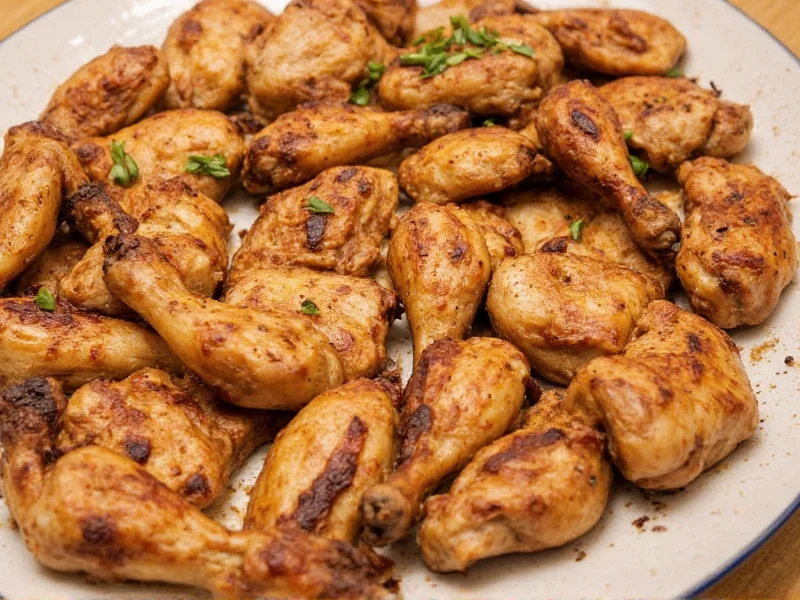Grilled chicken is a summer staple, but achieving perfectly seasoned meat requires more than just sprinkling on salt and pepper. The right seasoning blend transforms simple chicken into a flavorful centerpiece that keeps guests coming back for seconds. Understanding how different spices interact with high-heat cooking makes all the difference between dry, bland chicken and juicy, restaurant-quality results.
The Science Behind Seasoning Grilled Chicken
When chicken hits the grill, several chemical reactions occur that affect how seasoning works. The Maillard reaction—the browning process that creates complex flavors—begins around 285°F (140°C). Salt plays a crucial dual role: it enhances natural flavors while helping the surface dry slightly, promoting better browning. Acidic components like lemon zest or vinegar in marinades help tenderize the meat's surface without making it mushy.
Unlike oven cooking, grilling exposes chicken to intense direct heat, which can burn delicate herbs. This is why hardy dried spices generally work better than fresh herbs for dry rubs, though fresh herbs shine in finishing sauces or compound butters added after cooking.
Essential Components of Great Chicken Seasoning
Every successful seasoning blend contains these four elements working in harmony:
- Salt - The foundation that enhances all other flavors and helps retain moisture
- Aromatics - Garlic, onion, and shallot powders provide savory depth
- Herbs and Spices - Paprika, cumin, or dried herbs add complexity
- Acid or Heat - Citrus zest or cayenne pepper brightens and balances
Skipping any of these elements leaves your seasoning one-dimensional. For example, salt alone makes chicken taste flat, while herbs without salt become indistinct.
Top 5 Seasoning Blends for Different Flavor Profiles
While the basic blend works for most situations, these specialized mixes cater to specific tastes and cuisines. All measurements are for one pound of chicken.
| Flavor Profile | Seasoning Blend | Best For |
|---|---|---|
| Classic American | 1 tbsp salt, 1½ tsp black pepper, 1½ tsp garlic powder, 1 tsp onion powder, 1 tsp smoked paprika, ½ tsp dried thyme | Chicken breasts, drumsticks, family dinners |
| Mediterranean Herb | 1 tbsp salt, 1 tsp dried oregano, 1 tsp dried rosemary, 1 tsp garlic powder, ½ tsp lemon zest, ½ tsp red pepper flakes | Skin-on thighs, whole grilled chicken |
| Spicy Cajun | 1 tbsp salt, 1½ tsp paprika, 1 tsp garlic powder, 1 tsp onion powder, 1 tsp cayenne, ½ tsp thyme, ½ tsp oregano | Chicken wings, skewers, bold flavor lovers |
| Asian-Inspired | 1½ tsp kosher salt, 1 tsp garlic powder, 1 tsp ginger powder, 1 tsp five-spice powder, ½ tsp white pepper, 1 tbsp brown sugar | Chicken thighs, teriyaki variations |
| Lemon-Herb | 1 tbsp salt, 2 tsp lemon zest, 1 tsp dried dill, 1 tsp dried parsley, ½ tsp garlic powder, ½ tsp black pepper | Light summer grilling, healthy meals |
Timing and Application Techniques That Make a Difference
When and how you apply seasoning affects results more than many home cooks realize. For best results with dry rubs:
- Dry the surface - Pat chicken completely dry with paper towels before seasoning to help the rub adhere
- Season early - Apply salt-based rubs at least 45 minutes before grilling (or up to 24 hours for whole chickens)
- Oil lightly - A light coating of neutral oil (like avocado or grapeseed) helps spices stick without causing flare-ups
- Rub gently - Press seasoning into the meat rather than just sprinkling on top
For marinades containing acid (lemon juice, vinegar, yogurt), don't marinate longer than 2 hours for breasts or 4 hours for thighs, as the acid can begin to break down the proteins and make the surface mushy.
Avoiding Common Seasoning Mistakes
Even experienced grillers make these seasoning errors that compromise results:
- Using table salt instead of kosher - Table salt is denser and contains anti-caking agents that can make chicken taste metallic. Kosher salt's larger crystals distribute more evenly.
- Seasoning too late - Adding seasoning just before grilling doesn't allow time for flavors to penetrate or for salt to work its magic on the protein structure.
- Overcrowding spices - Too many competing flavors create confusion rather than complexity. Stick to 3-5 main components in your blend.
- Forgetting the sugar factor - Small amounts of sugar (¼-½ tsp per pound) help caramelization and balance savory flavors, but too much burns quickly on the grill.
Special Considerations for Different Cuts
Not all chicken parts need the same approach. Adjust your seasoning strategy based on what you're grilling:
- Boneless breasts - Use lighter seasoning with more acid components to prevent dryness. Consider brining first with ¼ cup salt dissolved in 4 cups water for 30 minutes.
- Bone-in thighs - Can handle bolder, spicier blends. The higher fat content carries flavors better and prevents drying.
- Skin-on pieces - Season under the skin for maximum flavor penetration. Lift the skin gently and rub seasoning directly on the meat.
- Wings and drumettes - Benefit from slightly heavier seasoning since they're often eaten with fingers and need pronounced flavor.
Storing and Preparing Homemade Seasoning Blends
Create large batches of your favorite blends and store them in airtight containers away from heat and light. Properly stored, most dry seasoning mixes maintain peak flavor for 3-6 months. Glass jars with tight-fitting lids work better than plastic, which can absorb odors.
For the freshest flavor, toast whole spices (like cumin seeds or coriander) in a dry skillet over medium heat until fragrant, then grind them yourself. Pre-ground spices lose potency quickly—check the "packed on" date and replace if older than 6 months.
When measuring blends, use proper measuring spoons rather than estimating. Consistent ratios are crucial for repeatable results, especially when doubling recipes for larger gatherings.











 浙公网安备
33010002000092号
浙公网安备
33010002000092号 浙B2-20120091-4
浙B2-20120091-4